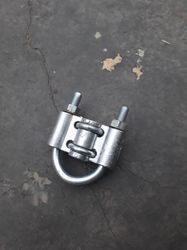Suspension Clamp
Price 30 INR/ Piece
Suspension Clamp Specification
- Conductor Shape
- Round
- Product Type
- Suspension Clamp
- Voltage
- High Voltage Volt (v)
- Application
- Industrial, Overhead
- Jacket Material
- PVC
- Connector Color
- Black
Suspension Clamp Trade Information
- Minimum Order Quantity
- 100 Pieces
- Payment Terms
- Telegraphic Transfer (T/T), Cheque
- Supply Ability
- 100 Pieces Per Day
- Delivery Time
- 2-3 Days
- Main Export Market(s)
- South America, Western Europe, Asia, Australia, North America, Middle East, Central America, Eastern Europe, Africa
- Main Domestic Market
- All India
About Suspension Clamp
Earthing hook stick, also known as a grounding hook stick or grounding rod stick, is a specialized tool used in electrical grounding and earthing systems. It is designed to facilitate the safe and efficient connection of grounding conductors or cables to grounding electrodes, such as ground rods or grounding plates. The earthing hook stick allows operators to establish a reliable electrical connection without direct contact with the grounding components, ensuring safety during installation or maintenance procedures.FAQ: Q: What is the purpose of an earthing hook stick?A: The primary purpose of an earthing hook stick is to safely establish electrical connections between grounding conductors and grounding electrodes. It enables operators to handle and manipulate grounding cables or conductors from a safe distance, minimizing the risk of electric shock during the earthing process.Q: How does an earthing hook stick work?A: An earthing hook stick typically consists of a long, insulated handle with a specially designed hook or clamp at the end. The hook or clamp securely attaches to the grounding conductor, allowing the operator to position it onto the grounding electrode. By manipulating the hook stick, operators can safely and accurately establish the electrical connection.Q: Where are earthing hook sticks commonly used?A: Earthing hook sticks are commonly used in various industries, including electrical utilities, construction, telecommunications, and industrial facilities. They are particularly useful during the installation, maintenance, or testing of grounding systems, ensuring that proper electrical safety measures are followed.Q: Are all earthing hook sticks the same length?A: Earthing hook sticks come in various lengths to accommodate different operational requirements. The length of the stick depends on factors such as the distance between the operator and the grounding component, the specific application, and the accessibility of the grounding electrode.FAQs of Suspension Clamp:
Q: What is the conductor shape of the Suspension Clamp?
A: The conductor shape of the Suspension Clamp is round.Q: What material is used for the jacket of the Suspension Clamp?
A: The jacket material used for the Suspension Clamp is PVC.Q: What applications are suitable for the Suspension Clamp?
A: The Suspension Clamp is suitable for industrial and overhead applications.Q: What voltage level does the Suspension Clamp support?
A: The Suspension Clamp is designed for high voltage applications.Q: What is the color of the Suspension Clamp connector?
A: The connector color of the Suspension Clamp is black.

Price:
- 50
- 100
- 200
- 250
- 500
- 1000+
More Products in AB Cable Accessories And Tension Hardware Category
Dead End Clamp 2 Bolt
Price 45 INR / Piece
Minimum Order Quantity : 500 Pieces
Connector Color : Silver
Conductor Shape : Round
Application : Industrial, Overhead
Voltage : High Voltage Volt (v)
I Bolt
Price 45 INR / Piece
Minimum Order Quantity : 500 Pieces
Connector Color : Yellow And Silver
Conductor Shape : Round
Application : Industrial, Overhead
Voltage : Medium Voltage Volt (v)
Dead End Clamp 3 Bolt
Price 85 INR / Piece
Minimum Order Quantity : 500 Pieces
Connector Color : Silver
Conductor Shape : Round
Application : Overhead, Industrial
Voltage : Medium Voltage Volt (v)
I hook
Price 30 INR / Piece
Minimum Order Quantity : 500 Pieces
Connector Color : Silver
Conductor Shape : Round
Application : Industrial, Overhead
Voltage : Medium Voltage Volt (v)

 Send Inquiry
Send Inquiry






 Send Inquiry
Send Inquiry Send SMS
Send SMS Call Me Free
Call Me Free